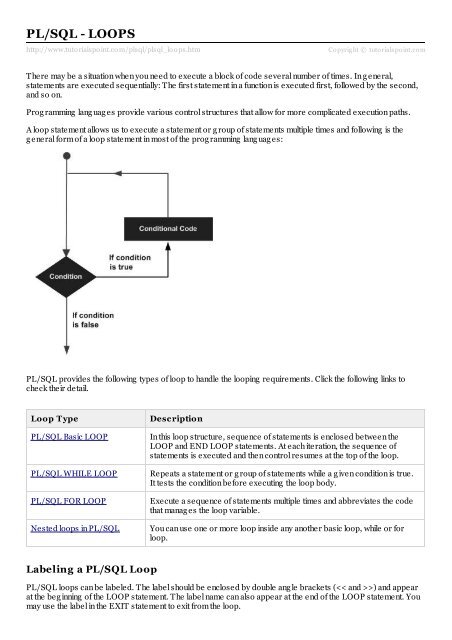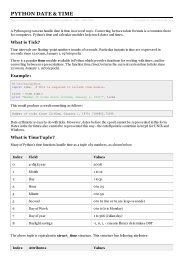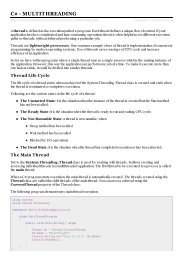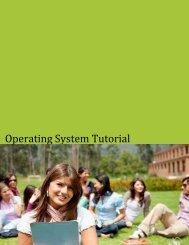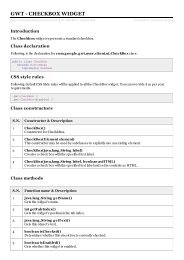PL/SQL Loops - Tutorials Point
PL/SQL Loops - Tutorials Point
PL/SQL Loops - Tutorials Point
You also want an ePaper? Increase the reach of your titles
YUMPU automatically turns print PDFs into web optimized ePapers that Google loves.
<strong>PL</strong>/<strong>SQL</strong> - LOOPS<br />
http://www.tuto rialspo int.co m/plsql/plsql_lo o ps.htm<br />
Copyrig ht © tutorialspoint.com<br />
There may be a situation when you need to execute a block of code several number of times. In g eneral,<br />
statements are executed sequentially: The first statement in a function is executed first, followed by the second,<br />
and so on.<br />
Prog ramming lang uag es provide various control structures that allow for more complicated execution paths.<br />
A loop statement allows us to execute a statement or g roup of statements multiple times and following is the<br />
g eneral form of a loop statement in most of the prog ramming lang uag es:<br />
<strong>PL</strong>/<strong>SQL</strong> provides the following types of loop to handle the looping requirements. Click the following links to<br />
check their detail.<br />
Loop Type<br />
<strong>PL</strong>/<strong>SQL</strong> Basic LOOP<br />
<strong>PL</strong>/<strong>SQL</strong> WHILE LOOP<br />
<strong>PL</strong>/<strong>SQL</strong> FOR LOOP<br />
Nested loops in <strong>PL</strong>/<strong>SQL</strong><br />
Description<br />
In this loop structure, sequence of statements is enclosed between the<br />
LOOP and END LOOP statements. At each iteration, the sequence of<br />
statements is executed and then control resumes at the top of the loop.<br />
Repeats a statement or g roup of statements while a g iven condition is true.<br />
It tests the condition before executing the loop body.<br />
Execute a sequence of statements multiple times and abbreviates the code<br />
that manag es the loop variable.<br />
You can use one or more loop inside any another basic loop, while or for<br />
loop.<br />
Labeling a <strong>PL</strong>/<strong>SQL</strong> Loop<br />
<strong>PL</strong>/<strong>SQL</strong> loops can be labeled. The label should be enclosed by double ang le brackets (>) and appear<br />
at the beg inning of the LOOP statement. The label name can also appear at the end of the LOOP statement. You<br />
may use the label in the EXIT statement to exit from the loop.
The following prog ram illustrates the concept:<br />
DECLARE<br />
i number(1);<br />
j number(1);<br />
BEGIN<br />
><br />
FOR i IN 1..3 LOOP<br />
><br />
FOR j IN 1..3 LOOP<br />
dbms_output.put_line('i is: '|| i || ' and j is: ' || j);<br />
END loop inner_loop;<br />
END loop outer_loop;<br />
END;<br />
/<br />
When the above code is executed at <strong>SQL</strong> prompt, it produces the following result:<br />
i is: 1 and j is: 1<br />
i is: 1 and j is: 2<br />
i is: 1 and j is: 3<br />
i is: 2 and j is: 1<br />
i is: 2 and j is: 2<br />
i is: 2 and j is: 3<br />
i is: 3 and j is: 1<br />
i is: 3 and j is: 2<br />
i is: 3 and j is: 3<br />
<strong>PL</strong>/<strong>SQL</strong> procedure successfully completed.<br />
The Loop Control Statements<br />
Loop control statements chang e execution from its normal sequence. When execution leaves a scope, all<br />
automatic objects that were created in that scope are destroyed.<br />
<strong>PL</strong>/<strong>SQL</strong> supports the following control statements. Labeling loops also helps in taking the control outside a loop.<br />
Click the following links to check their details.<br />
Control Statement<br />
EXIT statement<br />
CONTINUE statement<br />
GOTO statement<br />
Description<br />
The Exit statement completes the loop and control passes to the statement<br />
immediately after END LOOP<br />
Causes the loop to skip the remainder of its body and immediately retest its<br />
condition prior to reiterating .<br />
Transfers control to the labeled statement. Thoug h it is not advised to use<br />
GOTO statement in your prog ram.


